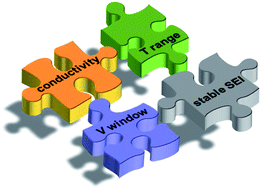Electrolytes are essential for the proper functioning of any battery technology and the emerging Na-ion technology is no exception. Hence, a major focus on battery research is to identify the most appropriate formulation so as to minimize interface reactions and enhance both cell performances and safety aspects. In order to identify suitable electrolyte formulations for Na-ion chemistry we benchmarked various electrolytes containing diverse solvent mixtures (cyclic, acyclic carbonates, glymes) and Na-based salts having either F-based or perchlorate anions and measured viscosity, ionic conductivity, and thermal and electrochemical stability. The binary EC:PC solvent mixture has emerged as the best solvent formulation and has been used to test the performance of Na/hard carbon cells with both NaClO4 and NaPF6 as dissolved salts. Hard carbon electrodes having reversible capacities of 200 mA h g−1 with decent rate capability and excellent capacity retention (>180 cycles) were demonstrated. Moreover, DSC heating curves demonstrated that fully sodiated hard carbon cycled in NaPF6–EC:PC exhibits the highest exothermic onset temperature and nearly the lowest enthalpy of reaction, thus making this electrolyte most attractive for the development of Na-ion batteries.

You have access to this article
 Please wait while we load your content...
Something went wrong. Try again?
Please wait while we load your content...
Something went wrong. Try again?


 Please wait while we load your content...
Please wait while we load your content...